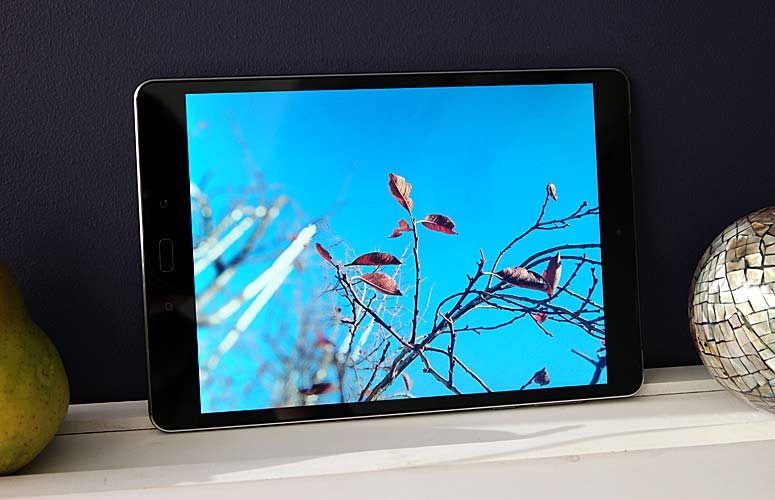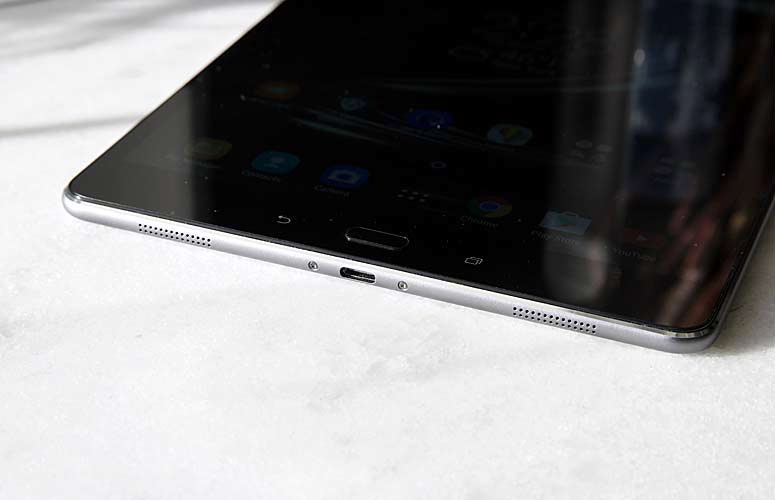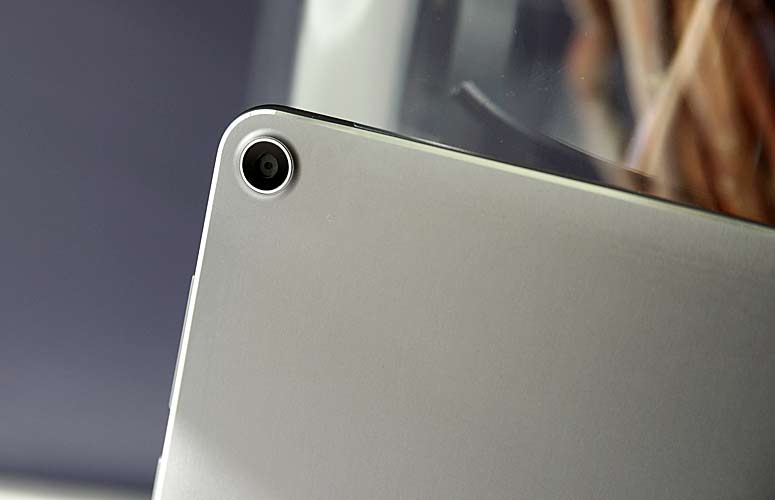Laptop Mag Verdict
The Asus ZenPad 3S 10 is a speedy and stylish 9.7-inch Android tablet that's great for media consumption.
Pros
- +
Fast performance
- +
Bright, vibrant display
- +
Sleek, beautiful design
- +
Strong audio
Cons
- -
Unimpressive cameras
- -
Below-average battery life
Why you can trust Laptop Mag
The Asus ZenPad 3S 10 is a 9.7-inch tablet made for Android users who don't want to compromise on performance or design. The $299 slate's aluminum shell and metallic, beveled edges may look straight out of Cupertino, but it runs a lightly skinned version of Android 6.0 Marshmallow. The ZenPad 3S 10 is lightning fast, and its bright, brilliant display and luxe design make this tablet a strong choice -- that is, if you're willing to live with its unimpressive cameras.
Design: iPad-esque
The Asus ZenPad 3S 10 comes in two color palettes: titanium gray with a black bezel, and glacier silver with a white bezel. We tested the gray model, which looks quite attractive. The black on its bezel is so close to the color of the screen that, when it's asleep, the front looks like a solid-black panel.
The ZenPad's shell and face feature diamond-cut, metallic, chamfered edges that shine in direct light. The tablet's aluminum back gives it a slick, premium look that resembles the backs of Apple's "space gray" iPads. The slightly protruding rear camera is another design touch that might cause some people to mistake this tablet for an iDevice.
The home button features a fingerprint reader that allows you to register up to five prints. The digit recognition is so speedy that I found myself unlocking the tablet before I could read the notifications on the screen.
Weighing 15.2 ounces and measuring 0.2 inches thick, the Asus ZenPad 3S 10 is heavier than the Huawei MediaPad M3 (11.4 ounces, 0.3 inches) and the LG G Pad F 8.0 (12.3 ounces, 0.4 inches), and similar in size and weight to the Apple iPad Air 2 (15.7 ounces, 0.2 inches).
Asus placed the ZenPad's SD memory slot on the top-left corner, its headphone jack on its top, and the volume and lock buttons on the right side. The company set the slate's USB Type-C port and speakers on the bottom edge.
Sign up to receive The Snapshot, a free special dispatch from Laptop Mag, in your inbox.
MORE: Best 2-in-1s (Laptop/Tablet Hybrids)
Display: Way colorful
The ZenPad's 9.7-inch, 2048 x 1536-pixel, bright display presents crisp pictures and rich, almost-too-vivid colors. As I watched the teaser for Guardians of the Galaxy Vol. 2, I noted that greens and blues of Gamora's and Yondu's skin looked incredibly vibrant, and that the red eyes of Star-Lord's goggles bore a strong glow. The high-res screen also let the 1080p trailer stream clearly, as I could make out slight details of Drax's scales and the moving parts of Star-Lord's retractable helmet.
In the Settings app, you can adjust the display to a Vivid preset, though I'd recommend you stick with the default Balance preset for the most accurate output. There's also a Bluelight filter setting to shift to the warmer colors that some believe make it easier to fall asleep.
The ZenPad's panel produces 113 percent of the sRGB gamut, making it more colorful than the G Pad F 8.0 (79 percent), the iPad Air 2 (100 percent) and the average for tablets (94 percent). The MediaPad M3 (123 percent) emits even more colors.
The ZenPad's 4.2 score on the Delta-E test isn't great (lower scores are better). The G Pad F 8.0 (1.8), the MediaPad M3 (2.6) and the tablet average (2.3) were more accurate.
The ZenPad's display emits up to 426 nits (a measure of brightness), which is similar to the Huawei MediaPad M3 (427 nits) and brighter than the G Pad F 8.0 (331 nits), the iPad Air 2 (368 nits) and the average for tablets (347).
Audio: Most impressive
Thanks to its strong speakers and support for high-res audio, the ZenPad has sound fit for audiophiles. The tablet pumped out enough volume to fill our large conference room with strong renditions of a variety of songs, from Radiohead's "Burn The Witch" to D.R.A.M.'s "Broccoli." From D.R.A.M.'s vibrating bass to Thom Yorke's delicate vocals, the slate produced these songs clearly and powerfully.
The ZenPad includes the AudioWizard sound-adjustment app, which offers several presets (Smart, Music, Movies, Gaming and Vocal). I recommend sticking with Smart for apps, video and podcasts, and then switching to Music when you're ready to kick out the jams.
AudioWizard also packs settings for in-ear and over-ear headphones, though I couldn't hear a strong difference during testing. There's also a preset for the Asus EL33 earbuds and support for the Hi-Res Audio (HRA) standard, which owners of those earbuds or music in that format may be excited to hear.
OS and Apps
The ZenPad runs a more or less stock version of Android 6.0 Marshmallow that features its ZenUI 3.0. The lock and home screens are slightly reorganized, icon edges appear rounded and there are a handful of Asus apps. All of these changes are easily ignored, especially Asus' own apps. In comparison, the MediaPad M3 runs a much less familiar version of Android, which is obscured by Huawei's EMUI skin.
The one stock feature we'd recommend you change out of the box is Asus' on-screen keyboard. It's too blocky and confusingly laid out in comparison to the stock keyboards on most devices. The Google Keyboard is a far cleaner input method.
The Asus Mobile Manager provides settings that allow you to customize the tablet's more granular preferences. You can control which apps send notifications from Android's Settings app, while the Power Saver menu offers a series of battery modes that can help the tablet preserve battery life or gain more speed.
The ZenMotion utility lets you wake the tablet by tapping on the screen twice, or you can draw a letter to jump straight into one of Asus' own apps while the slate is locked. Those gestures include drawing a "C" to open the camera and a "W" to open the weather. This worked well during my testing, and you can change the apps that ZenMotion opens with in the Settings app by tapping ZenMotion, tapping Touch Gesture and tapping on each of the shortcuts.
Performance
The MediaTek MT8176 Turbo CPU packs both a dual-core 2.1-GHz processor and a quad-core 1.7-GHz processor, paired with 4GB of RAM, to deliver fantastic speeds. I experienced buttery-smooth scrolling through websites and snappy transitions between apps, even with a dozen Chrome tabs, Slack, Todoist and OkCupid open. Games also played well on the tablet; the infinite pinball game PinOut and racing game Asphalt 8 ran without any stutter.
The tablet earned 3,270 on the Geekbench 4 test, which beats the category average of 2,994.
The ZenPad earned a decent score of 14,124 on the 3DMark Ice Storm Unlimited gaming benchmark, which is better than the G Pad F 8.0 (3,735) and on a par with the MediaPad M3 (15,375) and the average for tablets (15,504). However, it was worse than the iPad Air 2, which notched 21,660.
The fingerprint reader is so speedy that I found myself unlocking the tablet before I could read the notifications on the screen.
The ZenPad wiped the floor with its competition when transcoding a 1080p video to 480p in VidTrim, which took only 2 minutes and 52 seconds, blowing past the 8:23 average. The G Pad F 8.0 (13:00) and MediaPad M3 (3:14) needed more time to finish.
The slate needed only 7 seconds to open a 5.8MB PDF file. The MediaPad M3 was right on its heels, at 10 seconds.
The ZenPad also earned a good score in the JetStream JavaScript benchmark test (bigger is better), notching 57.7. That beats the MediaPad M3 (51.9) and the tablet average (49.2).
Cameras
The ZenPad's 8-megapixel rear and 5-MP front cameras capture decent, but occasionally washed out, photos. In one landscape, the tablet accurately captured blue skies and green shrubs, as well as some nice architectural details of a pillar on our rooftop. However, compositions fell apart when there was any strong light in the frame. Video shot on the tablet suffered from the same contrast problems, as well as some slight stuttering.
Both cameras come set to a lesser-megapixel setting in order to get a 16:9 aspect ratio, but if you're OK with the 4:3 ratio, you can increase the resolution.
As on many smartphones and tablets, the front-facing camera is set up to perform beautification tricks that clear your skin, enlarge your eyes and thin your face. It's easy to turn off these settings by tapping on the slider icons and lowering each slider to zero.
In comparison, the MediaPad M3's camera has a leg up on the ZenPad, with solid depth of field and color balance, but Apple gave best-in-class shooters to the iPad Air 2, which captures vibrant, detailed images and video.
Battery Life
The ZenPad offers pretty good battery life, but others last longer. The tablet endured for 8 hours and 9 minutes on our battery test (continuous web browsing over Wi-Fi). That beats the G Pad F 8.0 (7:11) but isn't as good as the MediaPad M3 (8:40), the tablet average (9:14) or the iPad Air 2 (9:20).
MORE: 10 Tablets with the Longest Battery Life
Bottom Line
The Asus ZenPad 3S 10 includes a stellar display, terrific performance and sweet sound that make it great for watching videos, multitasking and enjoying high-res audio. We also really like the sleek look and feel of this slate. However, the battery life could be better, and other tablets offer higher-quality cameras.
If you prefer a smaller screen, consider the 8.9-inch Huawei MediaPad M3 ($299), which snaps better-looking photos and offers longer battery life than the Asus ZenPad 3S 10, but note that its skinned version of Android is more obtrusive. If you can afford another $100 and don't mind iOS, get the $399 iPad Air 2, which has the best camera and battery life by far.
Overall, the ZenPad 3S 10 is a very good value because of its combination of strong design and entertainment features.
- Best Ultrabooks (Thin-and-Light Windows Laptops)
- Our Favorite Tablets for Work and Play
- Kids Tablets to Buy (or Avoid)
Asus ZenPad 3s 10 Specs
| Brand | ASUS |
| CPU | Mediatek 8176 Turbo Dual CA72 2.1GHz + Quad CA53 1.7GHz |
| Camera Resolution | 8MP |
| Card Reader Size | 128GB |
| Card Readers | microSD |
| Display Resolution | 2048 x 1536 |
| Display Size | 9.7 |
| Front-Facing Camera Resolution | 5MP |
| Graphics Chip | IMG GX6250 |
| Has Bluetooth | Yes |
| OS | Android 6.0 Marshmallow with ZenUI 3.0 |
| Ports | Headphone, USB Type-C |
| RAM Included | 4GB |
| Size | 9.47 x 6.44 x 0.23 inches |
| Storage Drive Size | 64GB |
| Storage Drive Type | eMMC |
| USB Ports | 1 |
| Weight | 15.20oz |
| Wi-Fi | 802.11a/b/g/n/ac |
Henry was a contributing writer at Laptop Mag. He penned hundreds of articles, including helpful how-tos for Windows, Mac, and Gmail. Henry has also written about some of the best Chromebooks, and he has reviewed many Apple devices, including various MacBook Air laptops. He is now a managing editor at our sister site Tom's Guide, covering streaming media, laptops, and all things Apple.






